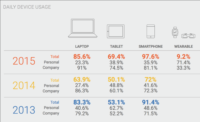As technology disruption continues to accelerate in our industry, this is likely being discussed in boardrooms around the world. Design firms and construction companies absolutely should become technology companies, but becoming a tech company is much different than becoming a software company.
Technology has always disrupted engineering. Consider the shift from bumwad to computer-aided design (CAD), and from CAD to building information modeling (BIM) and geospatial information systems (GIS). The difference today is that the changes are happening faster, at a pace that upskilling and behavioral adaptation can’t maintain. This rate of change has many seeing today’s technology disruption as something different, instilling fear of commoditization or even obsolescence.
Instead of fearing those things, we should see this disruption as an opportunity to not necessarily engineer faster or at lower costs, but to engineer better. This is the time for more optioneering, for finding more sustainable solutions, and for improving quality and safety. The last time we experienced a fear for commoditization of engineering services was during the global financial crisis of 2008. Pricing pressures were pervasive, but at that time the delivery methods for these services were generally the same. While technology was evolving and advancing, it remained a very linear process with hand offs and file exchanges.
Little did we know that machine learning and generative design algorithms were about to emerge.
They did so along with a host of other extremely progressive automation technologies associated with what we now often refer to as the Fourth Industrial Revolution – a blending of the physical and virtual world. These changes gave rise to intense automation and laid a foundation for more sophisticated and collaborative supply chain relationships.
Technology is now already in the DNA of most design firms and construction companies. How organizations position themselves and the pace at which they are prepared to move determine their success.
Atkins embraced the disruption and broadcasted a call to action for design firms and the contractors they work with early on. It was a commitment to shape how disruption could bring better value and outcomes. In early 2014, we began careful investigation of our own global revenue portfolio, recognizing that nearly a third of that portfolio was delivering detailed design and about another 15-20% was in some type of construction management and supervision. Considering the services most targeted for automation, we saw nearly half of our global revenues subject to material change.
Atkins began an intense period of evaluation, partnering with key clients to explore the spaces where we knew our engineering expertise stood out to determine what offerings were meaningful to our clients and just how far we could push technology to deliver higher value. We explored areas of intelligent mobility, digital engineering and digital asset management, and gradually started to extend traditional engineering services to the technology-enabled services thriving today.
Design firms and construction companies becoming more tech-focused should use caution and understand software development is far more encompassing and certainly isn’t something to be taken lightly. Construction engineers design bridges and buildings with required credentials, licenses and detailed plans to ensure safety and avoid putting lives at risk. Software engineers write code which controls multimodal transit, recognizes and protects our identity and hosts very personal data. We need to treat software development and related services the same way we treat construction engineering.
Design firms and contractors considering a transition to a more technology-focused organization find themselves in a tricky situation. While you want to leverage technology to improve your services and provide more to your clients, you must carefully weigh the risks and recognize whether you truly have the right skills. Just because you can write code doesn’t mean you should become a software company. Knowing where your organization’s strengths lie and where the gaps are is key. Find that unique sweet spot by understanding that crucial gap between your organization’s expertise and your client’s perception of value. What type and level of automation will fill the gap and deliver a better outcome?
Understanding the responsibility and the risks is important. You must also have the right business environment and the right leadership. Is your organization prepared to sustain software and product research and development even when product sales dip? Are you prepared to monitor, measure and forecast success by something other than headcount and resource utilization? Your leadership also must recognize the different business metrics, commercial models, and cultural norms that govern the technology and software realm. Rather than labor, time and materials, you focus on value offered and value gained.
You may be part of a large organization with a longstanding professional software development and delivery practice. Maybe it is a separate service offering, discrete from the traditional engineering services. Your organization can integrate from within and leverage the professional software skills to modernize its engineering service delivery. Perhaps your organization lacks these internal capabilities. Now is the time to start developing and cultivating them. You can also drive partnerships and alliances to achieve similar results. Whether the offering is developed from within or through partnerships, prepare for failures, but allow for creativity and investment.
Should design firms and construction companies become technology companies? I don’t believe there is a right or wrong answer, but today’s firms and companies must step boldly into technology. As to just how large a step to take requires a keen sense of organizational tolerance of taking risk and thinking differently.
Donna Huey is senior vice president and director of technology for Atkins North America supporting clients to manage both the opportunities and challenges posed by digital disruption. She has over 25 years of experience in engineering and environmental consulting services with an emphasis on applied technology and innovation. Huey co-founded Atkins North America's commercial IT business in 1996 and later launched her region’s first formal technology R&D program.




Post a comment to this article
Report Abusive Comment